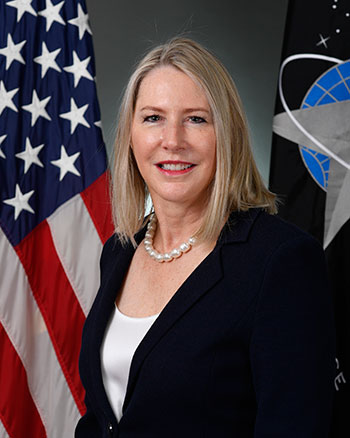 Dr. Lisa Costa, Chief Technology and Innovation Officer, U.S. Space Force
Dr. Lisa Costa, Chief Technology and Innovation Officer, U.S. Space Force
The U.S. Space Force’s “Vision for a Digital Service” states that “everything our operators experience is derived through data received from space and our ability to rapidly analyze that data to our advantage.”
Constellations recently spoke with Dr. Lisa Costa, the Chief Technology & Innovation Officer (CTIO) of the United States Space Force. In this role, she is charged with “unlocking and harnessing innovation to leverage increase speed and advantage.” Previously, Director of Communication Systems and the Chief Information Officer for the U.S. Special Operation Command she is now responsible for employing cutting edge technologies to digitally transform the United States Space Force (USSF.)
She began by explaining what is meant by calling the USSF a “digital service,” pointing out that it is the first military service formed during the digital age, making it imperative for it to be born digital.
“It is an opportunity for us to move toward digital engineering, digital headquarters, a digital workforce, and digital operations. A lot of the Guardians that we are bringing in are incredibly brilliant in STEM (Science, Technology, Engineering and Mathematics) and our focus is also making them fluid in IT (information technology) so that they can bring IT to their particular STEM disciplines and be able to automate capability for the Space Force,” she said.
Leap-Frog Over Catch-Up
Describing herself as “not a big believer in catching up, but more of a believer in leap-frogging,” Costa explained that the CTIO is focused on exploiting the disruptive and asymmetric capabilities to better compete and ensure that we and our allies have the necessary space capabilities when needed.
To her mind “disruptive” means looking at the big picture, the entire ecosystem of capabilities in space and envisioning how they can be utilized in new and innovative ways. The CTIO’s role is to help the Space Force understand what is happening in space, not only to react to events but to shape where space is going.
Just as “disruptive” means looking at the big picture, edge devices in Space Force are not limited to on-orbit devices but represent the entire chain of custody from satellite to submarine to shooter on the ground. In her words: “We need to ensure that we're our brother’s keeper, right? Providing capability to all domains from space and I think that's really a powerful, powerful construct.”
 Space Force Guardians might use the digital twin of a satellite to train on what that satellite can do, how it is built, and how they might be able to develop interesting tactics, techniques, and procedures using that asset.
Space Force Guardians might use the digital twin of a satellite to train on what that satellite can do, how it is built, and how they might be able to develop interesting tactics, techniques, and procedures using that asset.
Training With Digital Twins
Disruptive also applies to advanced training techniques such as “digital twins,” a precise virtual representation of a physical object or process. According to Costa it is an important element of the Digital Service as Space Force Guardians might use the digital twin of a satellite to train on what that satellite can do, how it is built, and how they might be able to develop interesting tactics, techniques, and procedures using that asset. When training Guardians, the only way they can experience their operational domain is through digital data where they can at least virtually touch and feel those assets and be able to physically and sensorially move them around and understand their capabilities.
Costa went on to state that digital twins need to be more accessible to small business. While large vendors have the technical resources to adopt digital engineering and to deliver the digital twins Space Force requires to train its Guardians, we need to ensure that the tools are there to enable small business to do the same types of things.
Industry and Academia Key to Space Force “Digital Service”
On whether industry has a role in creating the Digital Service, Costa emphasized that both industry and academia are critical components of this effort. She explained that industry has resources that the Space Force needs to take advantage of, such as expertise in optics, lasers, cyber and orbital mechanics. Space Force needs to leverage that expertise to develop new capabilities for the nation and its allies. “It’s all about ensuring that we have safe and secure transit ways in space so we can ensure that individuals have freedom of access,” she explained.
Ultimately what Space Force intends to do is move the processing of the data as close to collection as possible, whether that be beyond the asset itself, or move that data to an elastic computer capability in space. Space Force expects industry to advance the initiative of putting computing capability in space, which will ultimately include large data storage and on-orbit computer capability, to provide services to individuals and to organizations. Space Force will use that processing power to move artificial intelligence and machine learning closer to the asset that's collecting information, and then drive other assets and other capabilities in a tipping and queuing construct.
Engaging Academia
Addressing academia’s role, Costa described Space Force’s academic outreach as two-fold: first, as part of STEM research and development programs, and second, as part of a diversity and inclusion program to reach individuals who may not necessarily think about working for the government or going into a STEM environment.
Academia is a core element in Space Force’s diversity initiative. Costa described her own educational background where there was minimal gender and ethnic diversity in the STEM world. She believes that if STEM classes are not introduced until high school or college, Space Force will miss out on a lot of potential Guardians. As she said: “Students can't wait until high school and college; they need to start in elementary school and middle school and teachers need to have training assets to make STEM exciting and entertaining.”
She then explained how some people dislike STEAM, (Science, Technology, Engineering, Arts and Mathematics) the updated version of STEM, because it now includes the arts. But she firmly believes that that the arts are critical for STEM to be adopted because 90% of digital transformation is people-driven. If we don't have individuals who understand how to create sticky experiences that people want to use, the technology can be great, but it will sit out there on a shelf and never be used.
